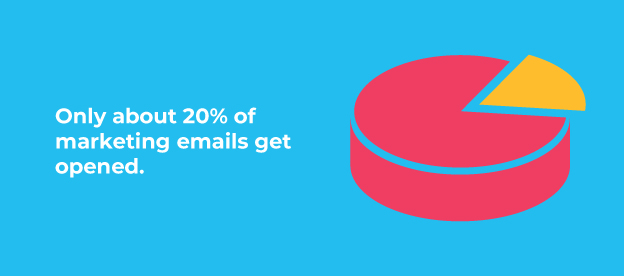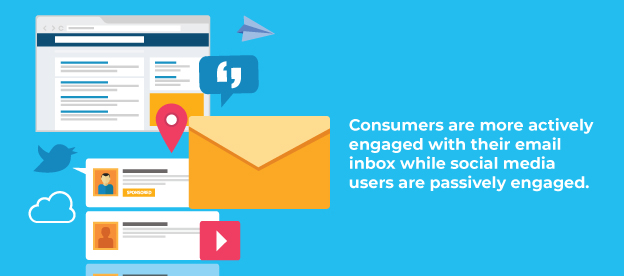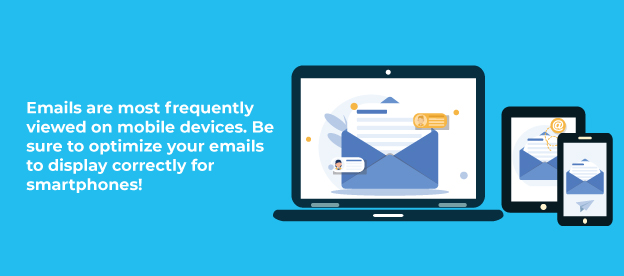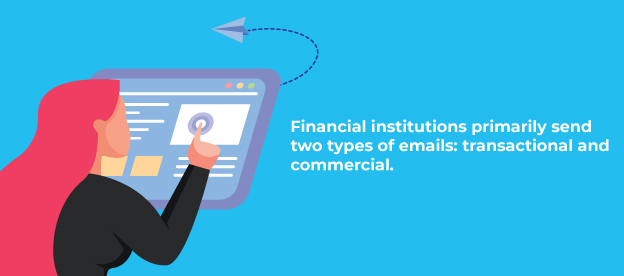Content Marketing
Are you looking for more useful conversion data? If you’re not already leveraging email marketing, you’re missing out on an important channel. Although only about 20% of marketing emails get opened, and 3% of those opens will click through to a landing page, this still provides additional customer engagement and data. All the more reason why email should not be an afterthought. With so much competition in your customers’ inboxes, your emails have to get noticed in the split-second decisions people make of whether to open or delete new messages. In this guide, we’ll explain everything you need to know about email marketing for financial institutions as well as the best strategies for getting more email opens.

What are the two types of emails from financial institutions?
The emails your bank or credit union sends will generally fall into one of the following two categories:
- Commercial: Advertises or promotes a commercial product or service, including content on a website operated for a commercial purpose.
- Transactional/Relationship: Facilitates an already agreed-upon transaction or provides an update about an ongoing transaction. For example, this could include email notifications for electronic statements, pending transactions, low or overdrawn account balance, unusual account activity, etc.
Your financial institution already sends transactional emails; it’s commercial content that sends many a financial executive into paroxysms of anxiety. We’ll address your concerns next.
Your Concerns About Email Marketing
Banking is a highly regulated industry as it is, so it’s no wonder that financial institutions are concerned about violating the CAN-SPAM Act, passed in 2003 to establish rules for commercial email; in particular, to make sure people that you email have opted in first to receive your messages and always have a way to opt out.
The main requirements include:
- Accurate header information (From, To, Reply-To, and routing information) that identifies the name of the individual or business sending the email.
- Avoid deceptive subject lines; they should reflect the nature of the message.
- Some kind of disclosure that the message is an ad.
- A valid physical address (street or P.O. box)
- Clear opt-out option such as an unsubscribe link. Cannot charge money or require personally identifying information to opt out.
- Opt-out requests must be honored within 10 business days.
Basically, anything outside of an account-related communication should be considered commercial. You can take these extra steps to make sure customers on your commercial list want to be there:
- Separate your transactional list from your newsletter/marketing list.
- After opting in to your marketing list, you can send an email requiring one more affirmative step to confirm they really want to get your emails.
- Follow up with people who don’t open 3-5 emails in a row. Are they still interested in receiving emails? Is there anything you can do to make the content more relevant?
Benefits of Email Marketing For Financial Institutions
Here is the case for not letting your concerns stop you from including email in your overall digital marketing approach.
- Showing up in customers’ inboxes can be more personal and direct than other marketing channels.
- Using data, you can proactively help people improve their financial situation through targeted resources and special offers.
- Email requires permission, which means the people on your list are interested in hearing from you. They probably could also use your help managing and optimizing their finances. Take a “help first; sell second” approach for the best results.
- Unlike traditional marketing tactics such as radio, billboard, print, and TV, email marketing is a relatively low cost investment.
- Segment your email list into groups with specific needs and goals such as new customer onboarding, education, lead nurturing, etc.
- It’s “future-proof,” meaning most people expect email to stick around a while.
Email Marketing vs. Social Media
Are you looking for more impressions? Your FI’s social media accounts may deliver a steady stream of impressions, but does that lead to action? It’s hard to measure. Whereas with email, you can expect to get more opens and more clicks than through social media; plus you can track what people do with your emails, from opening them to clicking through and forwarding to a friend.

In general, people’s engagement with their email inbox tends to be active, whereas scrolling through social media is more of a passive behavior. This doesn’t mean that you should abandon social media, but don’t think it’s enough and that you don’t need email.
Email Marketing Best Practices for FIs
Ready to add email marketing to your digital toolkit? You’re probably wondering how to start and where to go from there. Here are the best practices to keep in mind:
- Help first. We said it above but can’t say it enough. What today’s financial industry customers need is empathy and genuinely useful advice. If you try to go for an upsell or cross-sell first, it’s likely to go over about as well as a lead balloon.
- Optimize for mobile. These days your email is more likely to be read on a mobile device than a desktop computer. Make sure it’s easily readable and skimmable on a small screen. You can also add social media tie-ins to your emails (remember we said you didn’t need to abandon SM all together).
- Consider how risky your ask is. When crafting the right Call to Action, keep in mind how well your readers already know your brand and what you offer. Also remember how far along they are in the sales nurturing pipeline. For example, “learn more” is a smaller ask than “apply now.” When your CTA and audience are well-matched, you’ll see more success with your campaigns.
- Get personal. This means more than inserting your customers’ first names in the greeting line. Use data to figure out where they are in their financial lives, what their struggles are, how you could help them improve. Then send corresponding emails.
- Pay attention to subject line length. 65 characters seems to be the sweet spot, according to research published in The Financial Brand. Don’t ignore the preview/preheader text either. And keep in mind that your subject line should make a promise the body of the email follows through on.
- Write to one person. Use the pronoun ‘you’ and try to craft as many sentences as you can with your customer’s perspective in the lead. For example, “You need money to buy a new car; we can help with convenient auto loans” is better than “We offer affordable auto loans to help you get back on the road.”
- Keep them engaged. How do you keep your customer reading once they open your email? Using emotion and specific detail, concise sentences, and skimmable bullet lists all will improve the likelihood that your customer gets to the end of your message.

Need Help With Email Marketing?
If you’re already struggling to keep up with your existing marketing functions, adding email may feel overwhelming. Instead of trying to do it yourself, partner with a financial services digital marketing agency that already knows how to create winning email marketing campaigns for financial institutions. We can help drive conversions through email and give you the reporting you need to show that Marketing is a growth center, not just a cost center. Contact a digital marketing nerd today to get started!


